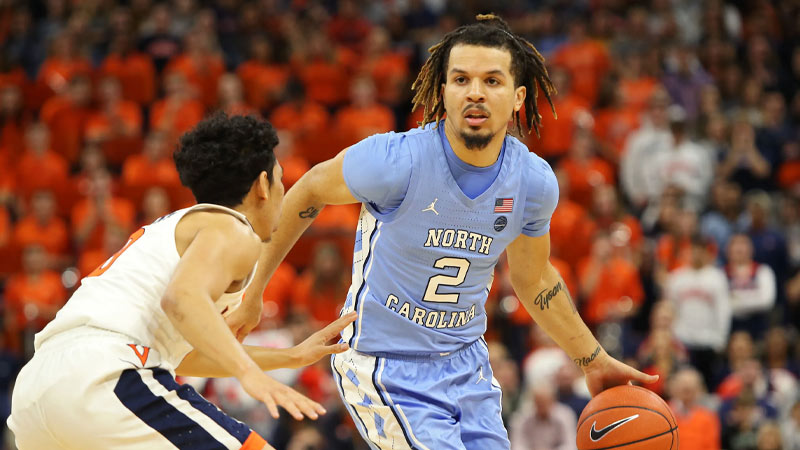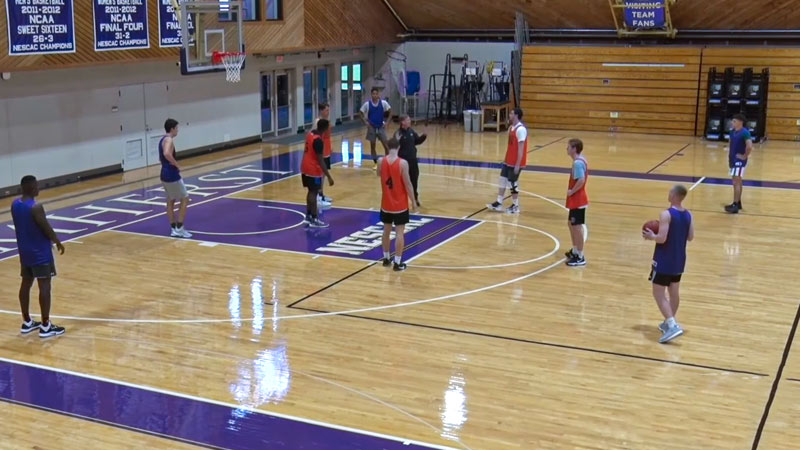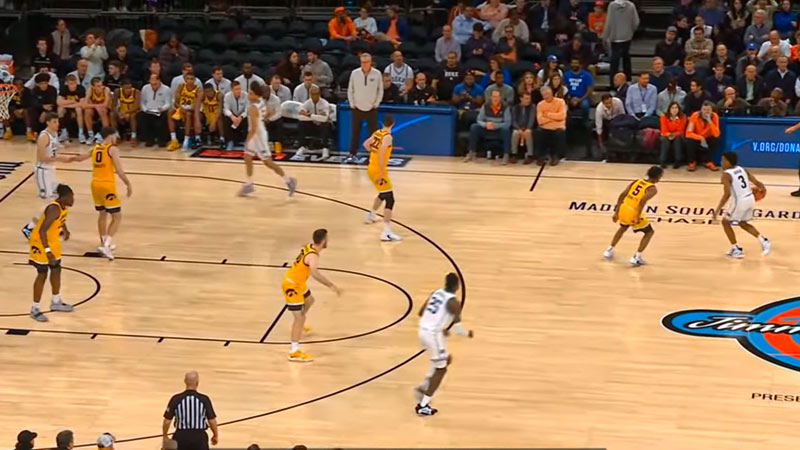Previously, we walked through 2-3 and 1-3-1 Zone Defense. Today, we are here with 1-2-2 Zone Defense Basketball.
To your surprise! 1-2-2 is nothing else than a variation of our very familiar 2-3 Zone, thus, another name of 1-2-2 defense is 32. And it’s popular for giving your offensive team a hard time!
The key difference between 1-2-2 and 2-3 defense is, the 2-3 offers more inside presence while the 1-2-2 excels against teams who score the majority of their points from the outside.
All five players in this formation guard the outer perimeter and are responsible to secure the area. This enables rapid closeouts and an opportunity to block every three-point attempt.
Let’s dive deeper to know more about this variation defensive strategy.
Defining 1-2-2 Zone Defense
The 1-2-2 zone defense is frequently deployed when we are facing a team with good outside shooters and guards but weak interior defenders.
In short, 1-2-2 is a basketball defensive strategy. Generally used for limiting low post goal opportunities, or penetration by dribble.
Also, when you are near the perimeter with on-ball pressure, this technique can help you control ineffective shots.
You have quick closeouts and can compete for every shot attempted from the three-point line.
Defenders’ Role in 1-2-2 Zone Defense?
Assuming how it works in the defense layout? As the name suggests, it’s a 1 (Point Guard) – 2 (Wing 1 & Wing 2) – 2 (Post Player 1 & Post Player 2).
Keep reading to learn more about the specific role and responsibilities of our defenders.
Point Guard (X1)

We have short names to mark every defender in 1-2-2 zone defense, X1 for point guard, and stands at the top of the key/ paint.
The point guard’s main duty is to apply defensive pressure to the player holding the ball up and to guard the high post areas.
He/ She must sync up with the offensive point player who is at the head of the key. At this point of defense, our point guard will let the offensive player cut through the high post.
However, dribblers headed to the wing or corner will be out of the defensive strategy.
The ball may move on either side of the court. Hence, the X1 defender will slide to secure the middle of the key.
Other players may call him upon to defend the opponent post players and he should be available to help.
Wing Players (X2 and X3)
We call the wing players X2 and X3. They are in charge of the first perimeter and will take place both on the left and right side of the point guard.
Both players must have their arms raised and move with at least one foot in the paint when the ball is at the top of the paint.
Since most of the high-percentage shots come from the high post, wing players must defend any pass forwarded to the high post. Also, push the opponent to go for the lower percentage shots.
Meanwhile, they should also keep the offensive player in check if they dribble to the corner of the court, until the post defender makes a switch.
Also, X2 and X3 players should also try to steal or prevent passes back to the wing to secure the point guard if the same offensive wing player gets to the center.
Post Players (X4 and X5)
In a row, X4 and X5 for our post players. Both post players must be half-fronting the low-post players and have at least one foot in the paint with the ball at the top of the key.
The post player – X5 is in charge of the player who receives the ball in the corner.
Meanwhile, the point guard (X1) and X4 will run to defend the low post on the ball side behind or from a quarter front, respectively.
However, both post players must alert the guards that they have a post player flashing up through the paint (if any), making the guards responsible for that player.
This is because the post players are unable to follow a low-post player past the middle of the lane when he gets to the high-post area.
Here’s an overview of how defenders should act in 1-2-2 zone defense basketball. In the next section, let’s talk about the key principles of 1-2-2 defense.
1-2-2 Zone Defense Basketball: Key Principles

The 1-2-2 defense is a variation from the original 2-3 zone defense. Hence, most of the core fundamentals will match with the 2-3 zone defense, such as preventing the ball from going to the high post, etc.
From the discussions above, we already have a genuine idea of what to expect of our defenders. Now, let’s take a detailed look at the key features of 1-2-2 defense in basketball.
1) Block High Post Entry
Following the 2-3 zone defense, the ball getting into the high post, might not be good news for you.
Therefore, our defenders must ensure that the ball doesn’t get to the high post, and allow no such openings for the opponent player.
A quick tip to nail it is the Denial Defense. To apply the trick, take your one hand through the passing lane. It should be in the middle of the ball and the offensive player of the high post.
Furthermore, focus on making any potential high post passes difficult to score or deflect. Because high post passes can often lead to a probable turnover.
You can advise your on-ball defenders to maintain active hands similar to the hands of the ball handler.
2) Jump Shots Must Be Limited
Like most other zone defenses, the 1-2-2 zone defense basketball is also designed to affect the jump shots. But this doesn’t allow the offensive players to have open jump shots without any challenge.
Rather, the 1-2-2 zone defense players should always attempt to close out with excellent footwork and block jump shots, especially against shooters who are below average.
Coaches! Advise your zone defenders from the back to keep this in mind, especially applicable to players who are typically power forwards and in the center of the team.
Because these defenders are typically slower than the defenders in the front or middle of the zone.
Hence, they should focus on performing effective closeouts to minimize open jump shots and dribble penetration.
3) Also Limit Low Post Attempts
Meanwhile, a low-post player with average offensive skills may and will receive the ball during a play.
He, then, can score swiftly and effectively against the closest zone defender by making a low post attempt.
But such moves can bust your defense! Prevent it by placing a hand in the passing route between the offensive low post player and the player with the ball who is close to the wing or corner.
While you are in charge of the low post area, you can perform a three-quarter front against the offensive low post player to prevent low post attempts.
In addition, even if the ball does enter the low post, one of the strong side perimeter zone defenders should double-team the offensive player in the low post.
Try to convince the offensive low post player to send the ball back to an offensive player on the perimeter.
Now, you should be safe from low post attempts and goals from the offensive players close to the wing or corner.
Reminder:
Double team strategy, a powerful defensive alignment where two defensive players are against one single offensive player, can be extremely useful against powerful wing or corner offensive players who are below average.
4) No Middle Dribble Penetration
Focus too much on the high and low post and it may leave the middle vulnerable to dribble penetration.
Dribble penetration is an offensive act when a player with the ball near the perimeter dribbles through a few openings in the defense, with his primary goal to take the ball to the basket.
For this reason, the closest off-ball zone defender should take the stand in the opening of the high post area (specifically between the high post and low post area) in case the ball gets to the wing.
Benefits of 1-2-2 Zone Defense Basketball
Professionals may prefer man-to-man defense instead of zone defense. But that totally depends on your perspective and how efficiently you can work it out.
Here are some of the reasons why you should consider playing in 1-2-2 zone defense.
1) When compared to the 2-3 zone, the 1-2-2 zone defense is more effective at preventing three-point shots.
2) You can also have easy adaptability to match up against different offenses.
3) The 1-2-2 zone defense offers excellent trapping opportunities, particularly in the corner.
4) You can put your players in an effective position to move into the fast break whenever there is a turnover. Especially when the top player in the middle and two wings are responsible for the turnover.
Follow this alignment, place your point guard on the wing, and top have a tall, athletic defender to finish.
5) This defense also mentors the tempo of the game and creates turnovers and fast-break opportunities.
6) Effective against inside scoring opportunities and ideal way to secure the key.
Weak Points of 1-2-2 Zone Defense Basketball
Also, check out some of the weaknesses of 1-2-2 defense you must be aware of.
1) The 1-2-2 zone defense can sometimes lead to defensive rebounding challenges since players are spaced out, leaving gaps for opponents to crash the boards.
2) The zone defense is most vulnerable when the opposition gets the ball into the high post. If your opponent has a powerful passing team, higher chances are your defense will get dismantled.
3) The 1-2-2 zone defense can leave the corners open, making them susceptible to quick ball movement and open three-point shots from the corners.
4) This defense in particular can leave the corners open, making it vulnerable to quick ball movement and open three-point shots from the corners.
5) Additionally, the success rate of the 1-2-2 zone defense can be highly affected by the opponent’s shooting performance.
With the opposition hitting outside shots constantly, you may struggle to maintain the durability of the zone.
1-2-2 Zone Defense Vs. 3-2 Zone Defense
Since 1-2-2 zone defense is a direct variation of 3-2 zone defense, here are the differences you should be expecting from 1-2-2 vs. 3-2.
The main difference lies in the playing style of the top defender; particularly when the ball arrives at the top of the key.
Other key differences are:
There are only two players on the perimeter to contest three-point shots. Thus, the 1-2-2 defense can be vulnerable to outside shooting.
On the other hand, the 3-2 defense is developed to better contest and discourage three-point attempts due to the higher number of perimeter defenders.
Another important factor you should learn about is how the two defense strategies enforce pressure differently.
The 1-2-2 defense can apply pressure on the ball handler to use the trapping strategies, especially near the wings and the baseline.
Meanwhile, in the 3-2 defense, our top defender doesn’t put the point guard under pressure. Rather, they fall back and block the pass to the high post alternatively.
However, it may be less effective in trapping because the 2-3 defense positions three players at the top.
In addition to that, the 1-2-2 defense has to prove to be more effective in protecting the key, on the contrary, the 3-2 still covers the paint but may not be as effective as the 1-2-2 defense.
Learn More About Basketball
Do you like our article on 1-2-2 zone defense basketball? If you do, don’t hesitate to share it with your friends and other basketball nerds!
The 1-2-2 zone defense can be a great way to defend your team and put the opponent under tight pressure. At some point, it even surpasses the 3-2 zone too.
If you are a coach and mentoring your team, you should choose wisely depending on your players’ ability and strength.
Even more, if you think they are best suitable for man-to-man defense, you should open up that door for them too.
And, if you are a basketball player, it is essential to be aware of the defense strategies in basketball, whether you are in defense or offense.
When you are playing offense, having proper knowledge about zone defense can help you break the defense shield of your opponent.
So, there is no alternative to learning more! Continue learning more about basketball with us. Keep an eye on our regular blog updates for more.







